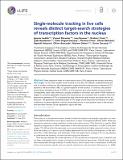| dc.contributor.author | Izeddin, Ignacio | |
| dc.contributor.author | Recamier, Vincent | |
| dc.contributor.author | Bosanac, Lana | |
| dc.contributor.author | Cisse, Ibrahim | |
| dc.contributor.author | Boudarene, Lydia | |
| dc.contributor.author | Dugast-Darzacq, Claire | |
| dc.contributor.author | Proux, Florence | |
| dc.contributor.author | Benichou, Olivier | |
| dc.contributor.author | Voituriez, Raphaël | |
| dc.contributor.author | Bensaude, Olivier | |
| dc.contributor.author | Dahan, Maxime | |
| dc.contributor.author | Darzacq, Xavier | |
| dc.date.accessioned | 2014-09-04T14:13:55Z | |
| dc.date.available | 2014-09-04T14:13:55Z | |
| dc.date.issued | 2014-06 | |
| dc.date.submitted | 2014-01 | |
| dc.identifier.issn | 2050-084X | |
| dc.identifier.uri | http://hdl.handle.net/1721.1/89167 | |
| dc.description.abstract | Gene regulation relies on transcription factors (TFs) exploring the nucleus searching their targets. So far, most studies have focused on how fast TFs diffuse, underestimating the role of nuclear architecture. We implemented a single-molecule tracking assay to determine TFs dynamics. We found that c-Myc is a global explorer of the nucleus. In contrast, the positive transcription elongation factor P-TEFb is a local explorer that oversamples its environment. Consequently, each c-Myc molecule is equally available for all nuclear sites while P-TEFb reaches its targets in a position-dependent manner. Our observations are consistent with a model in which the exploration geometry of TFs is restrained by their interactions with nuclear structures and not by exclusion. The geometry-controlled kinetics of TFs target-search illustrates the influence of nuclear architecture on gene regulation, and has strong implications on how proteins react in the nucleus and how their function can be regulated in space and time. | en_US |
| dc.description.sponsorship | Nikon France (Research contract) | en_US |
| dc.description.sponsorship | France. Agence nationale de la recherche (PCV DYNAFT 08-PCVI-0013) | en_US |
| dc.description.sponsorship | France. Agence nationale de la recherche (DynamIC ANR-12-BSV5-0018) | en_US |
| dc.description.sponsorship | Fondation pour la recherche médicale | en_US |
| dc.description.sponsorship | Netherlands Organization for Scientific Research (Rubicon fellowship) | en_US |
| dc.language.iso | en_US | |
| dc.publisher | eLife Sciences Publications, Ltd. | en_US |
| dc.relation.isversionof | http://dx.doi.org/10.7554/eLife.02230 | en_US |
| dc.rights | Creative Commons Attribution | en_US |
| dc.rights.uri | http://creativecommons.org/licenses/by/3.0/ | en_US |
| dc.source | eLife Sciences Publications, Ltd. | en_US |
| dc.title | Single-molecule tracking in live cells reveals distinct target-search strategies of transcription factors in the nucleus | en_US |
| dc.type | Article | en_US |
| dc.identifier.citation | Izeddin, Ignacio, Vincent Récamier, Lana Bosanac, Ibrahim I Cissé, Lydia Boudarene, Claire Dugast-Darzacq, Florence Proux, et al. “Single-Molecule Tracking in Live Cells Reveals Distinct Target-Search Strategies of Transcription Factors in the Nucleus.” Figure 2. Diffusion Properties of “free” Dendra2 and H2B. 3 (June 12, 2014). | en_US |
| dc.contributor.department | Massachusetts Institute of Technology. Department of Physics | en_US |
| dc.contributor.mitauthor | Cisse, Ibrahim | en_US |
| dc.relation.journal | eLife | en_US |
| dc.eprint.version | Final published version | en_US |
| dc.type.uri | http://purl.org/eprint/type/JournalArticle | en_US |
| eprint.status | http://purl.org/eprint/status/PeerReviewed | en_US |
| dspace.orderedauthors | Izeddin, Ignacio; Récamier, Vincent; Bosanac, Lana; Cissé, Ibrahim I; Boudarene, Lydia; Dugast-Darzacq, Claire; Proux, Florence; Bénichou, Olivier; Voituriez, Raphaël; Bensaude, Olivier; Dahan, Maxime; Darzacq, Xavier | en_US |
| dc.identifier.orcid | https://orcid.org/0000-0002-8764-1809 | |
| mit.license | PUBLISHER_CC | en_US |
| mit.metadata.status | Complete | |
